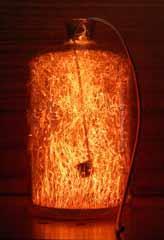Demonstrations designed to capture the student's imagination
Demonstrations to capture the student's imagination, by Adrian Guy of Blundell's School. In this issue: chromium(III) oxide-catalysed oxidation of ammonia
Catalysis is a fascinating subject covered at KS3, GCSE and A-level and there are many spectacular demonstrations that illustrate the process. The catalysed oxidation of ammonia gas is one of my favourites.
Catalyst for learning
There are several variations of this experiment using other catalysts, eg platinum wire or copper coins. For this demonstration chromium(III) oxide, made from the thermal decomposition of ammonium dichromate(VI)
((NH4)2Cr2O7), is used to catalyse the oxidation of ammonia gas into a mixture of water, nitrogen and nitric oxides:
4NH3(g) + 5O2(g) → 4NO(g) + 6H2O
The process produces heat and an awe-inspiring display of colour.

Kit
- ammonium dichromate(VI);
- glass rod (30cm); Bunsen burner;
- heat-resistant mats;
- a second-hand 20 l demijohn was used in this experiment, but a large beaker, with a heat-resistant mat as the cover for it, will do;
- 100 ml conc. ammonia solution;
- crucible (nickel or stainless steel);
- copper wire ca 1 mm diameter;
- metal drill bit (2 mm) and a drill;
- metal tube, eg copper or mild steel, 5-10 mm diameter, 1 m long;
- rubber tubing (1 m); heavy-duty nitrile gloves, goggles and a fume cupboard;
Procedure

In a fume cupboard carefully pour 10 g of ammonium dichromate(VI) onto the middle of a heat-resistant mat so that it forms a pyramidal-shaped pile. Heat the end of a glass rod in a roaring Bunsen flame to red heat and plunge the rod into the ammonium dichromate(VI) and hold until the 'volcano reaction' begins - usually for ca two seconds. After ca two minutes, pour the grey/green chromium(III) oxide product into a plastic container and put the lid on to seal - this keeps well for years.
In a fume cupboard pour 100 ml of concentrated ammonia solution into a large beaker and loosely cover the beaker with a heat-resistant mat so pressure build up of ammonia can be released. Leave for ca 10 minutes for a suitable concentration of ammonia gas to accumulate.
Attach a 1 m length of metal tube to the inside edge of a crucible. This is the hardest part of the experiment and it might be easier and safer to ask a friendly D&T teacher to prepare the apparatus. If you are making the apparatus yourself, clamp the crucible firmly in a vice and drill two 2 mm holes horizontally, 1 cm apart near the top of the crucible and then use copper wire to tie the tube inside the crucible. Bend the other end of the tube so that it hangs over the lip of the glass container. Connect a length of clean rubber tubing to this metal tube so that you can blow into it from a safe distance behind the closed fume cupboard window.
Half fill the crucible with the chromium(III) oxide produced by the 'volcano' and heat the base of the crucible over a roaring Bunsen flame to black heat for ca 30 seconds. Remove the heat-resistant mat from the beaker lid and lower the hot crucible into the ammonia gas. Close the fume cupboard window and gently blow into the rubber tubing to eject catalyst into the ammonia gas and start the reaction.
Special tips
For the ammonium dichromate(VI) volcano, switch off the fume cupboard to prevent the draft blowing your chromium(III) oxide everywhere. Make sure the ammonium dichromate(VI) is dry. Make sure the glass container is dry before adding ammonia solution. Notice the condensation formed on the glass vessel walls during the oxidation of ammonia.
This demonstration is best performed in a dark room if possible. A small-scale version can be done using a gas jar and a deflagrating spoon to introduce the hot catalyst.
Teaching goals
The main aim of the demonstration is to show that a catalyst increases the rate of a chemical reaction, but it also provides an opportunity to discuss the increased effect of the large surface area of the fine chromium(III) oxide powder used. The oxidation of ammonia to nitric acid is an important industrial process and proceeds via a similar mechanism, but using a platinum/rhodium catalyst.
Safety
All parts of the demonstration must be done in a fume cupboard. Wear goggles and gloves. Ammonium dichromate(VI) is explosive, a carcinogen, a teratogen and a mutagen, very toxic by inhalation, toxic if swallowed, and irritating to the skin. Chromium(III) oxide is irritating to the eyes, skin and respiratory tract. Ammonia is toxic by inhalation. Concentrated ammonia solution is corrosive and can burn the skin. Dispose of all products down a sink in the fume cupboard with plenty of water.









No comments yet